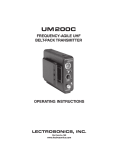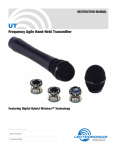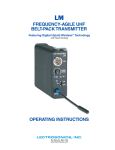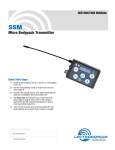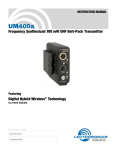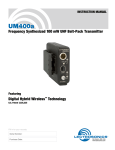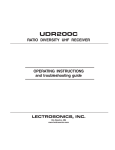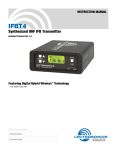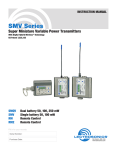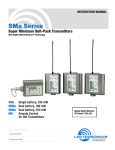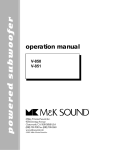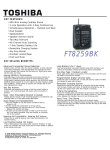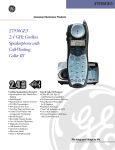Download UT200 Hand Held Transmitter Operating Instructions
Transcript
UT200 FREQUENCY-AGILE HAND-HELD TRANSMITTER OPERATING INSTRUCTIONS and trouble-shooting guide LECTROSONICS, INC. Rio Rancho, NM INTRODUCTION Thank you for selecting the Lectrosonics UT200 hand-held wireless transmitter. The UT combines over 80 years of engineering experience with the very latest components in a design that addresses the most demanding professional applications. The design of the UT200 was the direct result of numerous conversations with users, staging and touring companies and dealers across the US. The specific concerns and needs brought up in these conversations led directly to the development of the operational features offered on the UT200. Two hundred fifty six frequencies are user selectable in 100kHz steps to alleviate interference problems in travelling venues The UT200 is an integral microphone/transmitter with an internal antenna. The antenna is a dipole type utilizing the two printed circuit boards as the elements. The housing is composed of durable PVC, machined to a natural, comfortable shape. Internal mechanical parts are machined aluminum. Only the UT200 transmitters are covered in this manual. Companion receivers are covered in separate manuals. The UT200 will operate with any 200 Series Lectrosonics receiver in the same frequency group. TABLE OF CONTENTS INTRODUCTION ................................................................................................... 2 GENERAL TECHNICAL DESCRIPTION ............................................................. 3 CONTROLS AND FUNCTIONS ............................................................................ 5 BATTERY INSTALLATION ..................................................................................... 8 OPERATING INSTRUCTIONS.............................................................................. 9 OPERATING NOTES ............................................................................................. 9 ADJUSTING THE TRANSMITTER FREQUENCY ............................................. 10 TROUBLESHOOTING ......................................................................................... 11 SPECIFICATIONS ............................................................................................... 12 SERVICE AND REPAIR....................................................................................... 13 RETURNING UNITS FOR REPAIR .................................................................... 13 WARRANTY ........................................................................................... Back cover The UT200 transmitter is FCC type accepted under part 74: 470-608 MHz and 614-806 MHz UT200 Emission Designator: 180KF3E 2 Frequency Agile Handheld Transmitter GENERAL TECHNICAL DESCRIPTION The UT200 transmitters are comprised of a number of functional sub-systems as shown in the block diagram below. GENERAL The 200 system uses 75kHz wide deviation for an extremely high signal to noise ratio. The transmitter circuits are all regulated to allow full output power from the beginning (9 Volts) to the end (7 Volts) of battery life. The input amplifier uses a Motorola 33078 op amp for ultra low noise operation. It is gain controlled with a wide range input compressor which cleanly limits input signal peaks over 30dB above full modulation. DUAL BAND COMPANDOR Traditionally, compandors have been a source of distortion in wireless microphone systems. The basic problem with conventional systems is that the attack and decay times are always a compromise. If the time constants are fast, high frequency transients will not be distorted, but this will cause low frequency distortion. If the time constants are slower, low frequency audio distortion will be low, but high frequency transients will then be distorted. The 200 system introduces an entirely new approach to solving this basic problem, called “dual-band companding.” There are actually two separate compandors in the 200 system, one for high frequencies and one for low frequencies. A crossover network separates the frequency bands at 1kHz with a 6dB per octave slope, followed by separate high and low frequency compandors. The attack and release times in the high frequency compandor are fast enough to keep high frequency transient distortion at a low level, and the low frequency compandor uses slower time constants, reducing low frequency distortion to well below that of a conventional compandor. NO PRE-EMPHASIS/DE-EMPHASIS The signal to noise ratio of the 200 system is high enough to preclude the need for conventional pre-emphasis (HF boost) in the transmitter and de-emphasis (HF roll off) in the receiver. Pre-emphasis and de-emphasis in an FM radio system usually provides about a 10dB improvement in the signal to noise ratio of the system, but the high frequency boost in the transmitter must be removed in a purely complementary manner or else the frequency response of the original audio signal will be altered. Pre-emphasis can also cause distortion in the receiver. As this signal is passed through the IF filters in the receiver, distortion can be produced, most noticeably at full modulation. De-emphasis cannot be applied until the signal is converted into audio, so there is no way around this problem short of eliminating pre-emphasis altogether. Neither of these problems occur in the 200 system. The dual-band compandor in the 200 Series system essentially provides a dynamic pre-emphasis/de-emphasis function with extremely low distortion. PILOT TONE SQUELCH The 200 system utilizes an ultrasonic tone modulation of the carrier to operate the receiver squelch. This “pilot tone” consists of a 32kHz signal mixed with the audio signal following the microphone preamp, just after the compandor, to MIC ELEMENT PREAMP COMPANDOR INPUT AMP LP FILTER COMPANDED AUDIO TO XMTR AUDIO LEVEL Vref LIMIT LED SHUNT LIMITER BASS LP FILTER TREBLE HP FILTER PILOT TONE OSC Vreg +9VDC PWR LED +5VDC MUTE SET LED PWR Vreg PEAK AUDIO INDICATOR & LIMITER DRIVER +3.6VDC PHASE LOCKED LOOP PRESCALER COMPANDED AUDIO DIVIDER FREQ SWITCHES VOLTAGE CONTROLLED OSCILLATOR LOW PASS FILTER TRANSMITTER Rio Rancho, NM - USA 3 control the audio output muting of the receiver. The pilot tone is filtered out of the audio signal immediately after the detector in the receiver so that it does not influence the compandor or various gain stages. The basic benefit of the pilot tone squelch system is that the receiver will remain muted until it receives the pilot tone from the matching transmitter, even if a strong RF signal is present on the carrier frequency of the system. This is extremely important in applications such as with an automatic microphone mixer. WIDE-BAND DEVIATION 75kHz deviation improves the capture ratio, signal to noise ratio and AM rejection of a wireless system dramatically. Almost all other wireless systems use less than 75kHz deviation. LONG BATTERY LIFE High efficiency circuits throughout the design allow over 4 hours of operation using a single 9 Volt alkaline battery (over 12 hours with a new lithium battery.) The battery compartment is a unique mechanical design which automatically adjusts to fit any brand of alkaline or lithium battery. Battery replacement is easily accomplished by releasing the bottom and removing the battery cover. The battery contacts are spring loaded to prevent “rattle” as the unit is handled. The UT200 contains a battery status monitoring circuit which monitors and sends the battery status to the UDR200B receiver. The battery status is displayed on the front of the receiver. FREQUENCY AGILITY The transmitter section uses a synthesized, frequency selectable main oscillator The frequency is extremely stable over a wide temperature range and over time. Two rotary switches, located on the side of the unit, provide 256 frequencies in 100kHz steps over a 25.5MHz range. This alleviates carrier interference problems in mobile or travelling applications. ANTENNA The high output antenna utilizes the lower half of the printed circuit boards as one radiating element, with the upper half of the PC boards and mic capsule as the other half of the dipole configuration. This allows the mic to be held in any position, since the user’s hands have little or no effect on the radiated power. MICROPHONE ELEMENT The UT200 includes the Lectrosonics VariMic mic element. The VariMic is an cardioid condenser back electret microphone that is adapted for the unique circumstances of wireless microphones. The problems it solves are dynamic range, handling noise and low frequency noise (rumble or wind). In the VariMic, an unusual pumped source FET circuit increases the usable dynamic range 12dB and greatly reduces distortion, just as if the FET were being supplied with 48 Volts. In addition, a unique 16 position sensitivity control at the element itself can adjust the sensitivity in 15 steps over a 15 dB range. This is in addition to the normal gain control in the wireless microphone. The result is the widest dynamic range of any condenser mic in a wireless microphone. The VariMic has a three point damped rubber suspension to reduce high frequency handling noise and a generous sized windscreen to keep wind noise and breath pops away from the microphone. Low frequency noise is much more of a problem with wireless microphones than with conventional microphones. With a regular mic, low frequency wind noise, breath thumps or handling rumble can be filtered out at the control board before the noise causes problems with the following electronics or speaker systems. But with a wireless microphone, the electronics that will be overdriven are right in the wireless microphone. Filtering at the control board is much too late. To solve this problem, the VariMic has a low frequency filter that is so sharp that it can remove low frequency noise without affecting any wanted vocals. It consists of a 36 dB per octave filter circuit to sharply remove low frequency noise below 75 Hz without affecting vocal fundamentals. The lowest operatic bass voice fundamental is 82 Hz. Isn’t it nice to know that it will come ripping right through. 4 Frequency Agile Handheld Transmitter CONTROLS AND FUNCTIONS EXTERNAL “P” SWITCH – POWER ON/OFF A slide switch which turns battery power on and off. The LED next to the switch lights up when the “P” switch is turned on. This LED also serves as a battery condition indicator. The LED will glow brightly when the battery is good and will dim as the battery condition deteriorates. The LED is at full brightness with a new battery. When the battery voltage reaches 7 Volts, the LED will be completely dark. Note: this LED will not light if the EXT LED switch is in the OFF position. Audio On/Off Power On/Off A P “A” SWITCH – AUDIO ON/OFF A slide switch which “mutes” the audio in the OFF position and allows the audio gain (modulation level) of the transmitter to be adjusted without feedback from the sound system. This switch will do nothing if the EXTERNAL SWITCHES switch is in the BYPASS position. INTERNAL FREQUENCY ADJUST Two rotary switches adjust the center frequency of the carrier. The 1.6M is a coarse adjustment and the 100K is the fine adjustment. Each transmitter is factory aligned at the center of its operating range. The default position of the frequency select switches is in the center of the transmitter’s range. See page 10 for details on adjusting the transmitter frequency. Frequency switches located behind door. MOD LEVEL LEDs These LEDs (loacted under the battery door) indicate the audio input level and are used when adjusting the transmitter AUDIO LEVEL (gain) control. As the audio level increases, first one LED lights. The other LED lights as the audio level reaches maximum modulation. The LEDs are located underneath the battery cover, next to the AUDIO LEVEL control and are easily viewed when holding the transmitter in a normally used position. Mod Level LEDs AUDIO LEVEL Gain Control AUDIO LEVEL This knob (also located underneath the battery door) is operated while speaking or singing into the transmitter to adjust the audio gain of the transmitter for the correct amount of modulation. The LEDs located next to it indicate the modulation level as the gain is adjusted. See page 6 for details on this very important adjustment. EXTERNAL SWITCHES BYPASS This concealed slide switch defeats the external switches on the bottom panel for applications where it is best that the user not be able to operate the power and mute switches. The external switches are bypassed when this switch handle is moved toward the bottom of the unit. Bypass Switches EXTERNAL SWITCHES BYPASS EXTERNAL LED OFF EXTERNAL LED OFF This slide switch defeats the battery status LED on the bottom panel for applications where the LED may be distracting. With this switch in the right-hand position, the power will remain on and the transmitter operating, even though the power LED is off. The external LED is disabled when this switch handle is moved toward the bottom of the unit. Rio Rancho, NM - USA 5 Internal Controls - VariMic Version The VariMic head includes adjustments for Bass, Midrange and Treble response. There is also an attenuation adjustment to provide up to 15dB of additional headroom if needed. Bass / Mid / Treble The bass and treble controls will boost/cut by up to approximately 8dB while the Mid control will boost/cut up to about 6dB. These controls operate as standard tone controls. Counter-clockwise will reduce the response in that band and clockwise will provide a true boost. These controls can be accessed by removing the windscreen. To remove the windscreen, grasp the body of the transmitter in one hand and the windscreen in the other hand. Carefully unscrew the wind-screen counter-clockwise until it comes off then carefully slide the windscreen past the mic element. • Set flat, the mic capsule is very wide range and sounds a lot like a large competitor’s top line condenser mic. • Bass cut gives a dry but highly intelligible sound. Crisp. • Bass boost “fattens” the sound but is very listenable. Does not get midbass boomy. • Midrange cut sounds very smooth. Almost a “crooner” quality. A sweet sound. • Midrange boost is likely to be useful in a system that is midrange shy. • Treble cut has a “mellow” sound. The capsule has a solid high end so a little cut does not ruin the response. • Treble boost might be fine on some sound systems. The sound doesn’t get harsh (showing that the response was smooth) but sibilants are a little too much. Should be used in moderation. Bass Filter In addition to the tone controls, the UT200 also has a built in bass filter. This filter is fixed and cannot be adjusted or defeated. Low frequency noise is much more of a problem with wireless microphones than with conventional microphones. With a regular mic, low frequency wind noise, breath thumps or handling rumble can be filtered out at the control board before the noise causes problems with the following electronics or speaker systems. But with a wireless microphone, the electronics that will be overdriven are right in the wireless microphone. Filtering at the control board is much too late. To solve this problem, the VariMic has a low frequency filter that is so sharp that it can remove low frequency noise without affecting any wanted vocals. It consists of a 36 dB per octave filter circuit to sharply remove low frequency noise below 75 Hz without affecting vocal fundamentals. The lowest operatic bass voice fundamental is 82 Hz. See the curve below. BASS MID TREBLE Attenuator The VariMic head includes an attenuator to provide an additional 15dB of headroom when needed. The attenuator should only be used when the normal Mic Level pot is already turned down as far as it will go and the signal through the mic is still too hot. The attenuator control is a 16-position switch marked 0 through F. “F” is minimum attenuation or the highest signal level. “0” is maximum attenuation or the lowest signal level. For the maximum amount of headroom, set the switch to “0.” UT200 Bass/Midrange/Treble Boost/Cut +10 +5 0dB -5 -10 6 10Hz 100Hz 1KHz 10KHz Frequency Agile Handheld Transmitter Note: The attenuator should not be used as a level control. The Audio Level control inside the battery compartment is the main level control. Adjust the attenuator only when the Audio Level control is turned completely down and more headroom is still needed. Be sure to set the attenuator back to its original setting for normal operation. UT200 Bass Filter 20 0dB -3dB @ 71Hz -20 -20dB @ 50Hz -40 -60 10Hz 100Hz 1KHz 10KHz ATTENUATOR Rio Rancho, NM - USA 7 BATTERY INSTALLATION The transmitter is powered by a standard alkaline 9 Volt battery. It is important that you use ONLY ALKALINE or LITHIUM batteries for reliable operation. Alkaline batteries will provide about 4 hours of operation while the lithium batteries will operate the transmitter for over 12 hours. The battery status lamp will function normally only with alkaline or lithium batteries. Standard zinc-carbon batteries marked “heavy duty” or “long-lasting” are not adequate. They will provide only about 30 minutes of operation. Similarly, nicad rechargeable batteries only provide about 1 hour of operation, and will run down quite abruptly. The battery compartment is located in the lower section of the transmitter, between two printed circuit boards. To install a fresh battery, follow the steps illustrated below. Pull Ring Outward Rotate Ring 1/8 Turn A Remove Cover P STEP1 STEP3 STEP2 + Insert Battery – Rotate Ring To Lock Closed A Replace Cover P STEP4 STEP6 STEP5 Ring will sit flush in the closed position. + – Alternate Method Depress the plunger with the corner of the battery and slide the battery into the compartment. Note that the locking ring is in the closed position for this procedure. Look inside the battery compartment when the cover is off and take note of the two differently sized holes in the battery contact pad. Insert the battery so that the large hole in the battery contact pad will line up with the large contact on the battery when it is installed. The spring-loaded plunger in the bottom of the compartment (opposite the contact pad) secures the battery in place. The battery status is indicated by an LED on the bottom panel. The LED will glow brightly when the battery is good and will dim as the battery condition deteriorates. The LED is at full brightness with a new battery. (Be sure this LED is enabled with the EXT LED switch in the battery compartment. The battery status is also displayed on the Information Display on the front panel of the UDR200B Receiver. See the UDR200B manual for further details. Note: It is possible to insert the battery backwards and still be able to close the battery door. No damage will occur but the transmitter will not operate in this condition. 8 Frequency Agile Handheld Transmitter OPERATING INSTRUCTIONS 1) Install a fresh battery according to the instructions on page 8. Leave the battery cover off for further adjustment. 2) Set the internal bypass slide switches so that the battery status LED and the bottom panel switches will operate. 3) On the bottom panel, move the “A” (audio) switch to “OFF” (away from the LED) and the “P” (power) switch to ON (toward the LED) in that order. Observe that the battery status LED is brightly lit. If the LED is dim, replace the battery. 4) Hold the microphone in the same position that will be used in actual operation. 5) While speaking or singing at the same voice level that will be actually used, observe the MOD LEVEL LEDs next to the battery compartment. Adjust the AUDIO LEVEL control knob until the LEDs begin to light. Start at a low setting where neither LED lights as you speak. Gradually, turn the gain up until one LED lights, then the other. The first LED lights when the audio level is about 10 dB below full modulation. The second LED lights when the limiter begins to operate. There is 30 dB of headroom above the limiter LED and it is normal that it lights up 5% to 10% of the time during use. If you find that the AUDIO LEVEL control is set to minimum and the LIMIT LED is still on often, then adjust the attenuator or set the –10 dB switch to the –10dB position. These controls are located under the windscreen. Unscrew the windscreen and carefully lift it off the top of the unit. See pages 6 and 7 for these adjustments. If you need to change these controls, be sure to repeat the gain adjustment procedure beginning at step 3. 6) Once the gain has been adjusted, the transmitter audio can be turned on to make sound system level adjustments. Set the “A” (audio) switch to ON position and adjust the receiver and/or sound system level as required. Please note, there will be a 3 to 6 second delay between the moment the switch is thrown and the time when audio will actually be present. This intentional delay eliminates turn on thumps, and is controlled by the pilot tone squelch control. OPERATING NOTES The AUDIO LEVEL control knob should not be used to control the volume of your sound system. This gain adjustment matches the transmitter gain with the user’s voice level and microphone positioning. If the mic level is too high - both LEDs will light frequently or stay lit. This condition may cause distortion. If the mic level is too low - neither LED will light, or the LEVEL LED will light dimly. This condition may cause hiss and noise in the audio. The first LED turns on at -10dB below full deviation. The limiting LED turns on at full deviation and indicates that the input shunt compressor is operating. The input compressor operates over a full 30dB range regardless of the gain control setting. The compressor uses a true absolute value circuit to detect both positive and negative peaks. The attack time is 2 milliseconds and the release time is 80 milliseconds. Occasional limiting is desirable, indicating that the gain is correctly set and the transmitter is fully modulated for optimum signal to noise ratio. Different voices will usually require different settings of the AUDIO LEVEL control, so check this adjustment as each new person uses the system. If several different people will be using the transmitter and there is not time to make the adjustment for each individual, adjust it for the loudest voice. Rio Rancho, NM - USA 9 ADJUSTING THE TRANSMITTER FREQUENCY If you are experiencing interference from another signal on your frequency, you may want to change the operating frequency of your system. The switch nearest to the mic element changes the operating frequency by 100 kHz per step and the switch furthest from the mic element changes it 1.6 MHz per step. If you are experiencing interference, change the operating frequency of the receiver to find a clear channel, then set the transmitter to match. Note: These switches also appear on the front panel of the UDR200A version of the studio receiver and on the rear panel of the UCR200D version of the compact receiver. Normally, you should set the transmitter switches to match the receiver switch settings. With the UDR200B version of the studio receiver, the front panel LED character display will indicate the correct transmitter switch settings. 1.6M 100K Frequency Switches To gain access to the Frequency Switches, pull the access door straight out. It is held in place magnetically. There is a “doorknob” provided for gripping. Frequency Switches 100 kHz 1.6 MHz Door Knob Magnetic Door UT200 Internal Controls 10 Frequency Agile Handheld Transmitter TROUBLESHOOTING Before going through the following chart, be sure that you have a good battery in the transmitter. It is important that you follow these steps in the sequence listed. SYMPTOM POSSIBLE CAUSE TRANSMITTER BATTERY LED OFF 1) External LED is turned off. Check internal slide switch. 2) Battery is inserted backwards. 3) Battery is dead, or too low to be used. NO TRANSMITTER MOD LEVEL LEDs 1) Gain control turned all the way down. 2) Battery is in backwards. Check power LED. 3) Mic capsule is damaged or malfunctioning. Contact the factory for repair. RECEIVER RF LAMP OFF 1) Transmitter not turned on. 2) Transmitter battery is dead. 3) Receiver antenna missing or improperly positioned. 4) Transmitter and receiver not on same frequency. Check labels on transmitter and receiver and the frequency switch settings. 5) Operating range is too great. NO SOUND AND RECEIVER AUDIO LEVEL METER DOES NOT INDICATE NO SOUND BUT RECEIVER AUDIO LEVEL METER INDICATES Transmitter audio muted. Make sure bottom panel “A” switch is turned on. Push switch toward the letter “A” to turn the audio on. 1) Receiver audio is muted or set too low. 2) Receiver audio output is disconnected or cable defective or mis-wired. 3) Sound system or recorder input is turned down. DISTORTED SOUND 1) Transmitter gain (audio level) is too high. Speak or sing into the transmitter and check mod level lamps on transmitter and receiver. (See page 9) 2) Receiver output level may be too high for the sound system or recorder input. 3) Excessive wind noise or breath “pops.” Microphone may require an additional wind screen. 4) Transmitter frequency switches mis-set. HISS AND NOISE -- AUDIBLE DROPOUTS 1) Transmitter gain (audio level) too low. 2) Receiver antenna missing or obstructed. 3) Operating range too great. 4) Transmitter frequency switches mis-set. EXCESSIVE FEEDBACK 1) Transmitter gain (audio level) too high. Check gain adjustment and/or reduce receiver output level. 2) Microphone too close to speaker system. 3) Move microphone closer to the user’s mouth, and lower the sound system volume. Rio Rancho, NM - USA 11 SPECIFICATIONS Operating Frequencies: 486.4 to 588.7 and 614.4 to 793.6 MHz RF Power Output: 100mW Pilot Tone: 32.765 kHz, ±2 Hz, 5kHz deviation Frequency Stability: ±0.002% Deviation: ± 75 kHz max Spurious Radiation: Effectively none below 1GHz, above 1GHz At least 50dB below the carrier Equivalent Input Noise: –126 dBv Input Level: Maximum SPL depends on mic element used Input Compressor: Soft compressor, >30 dB range Gain Control Range: 43 dB, semi-log rotary control Modulation Indicators: Dual LEDs indicate modulation level 10 dB below clipping and at the onset of limiting Controls: Power ON/OFF, Audio ON/OFF and Battery Condition LED located on bottom of unit; Bypass controls located inside battery door Gain control located inside battery door; Frequency switches to adjust the transmitter frequency in 1.6 MHz and 100 kHz increments located just below the mic head on the outside body of the case. Battery Precision compartment auto-adjusts to accept any known alkaline or lithium 9 Volt battery. (We’ve tried 125 different ones!) Weight: 13.2 ozs. with VariMic capsule and alkaline battery Dimensions: 9." long x 2.05" diameter (at largest point) with VariMic capsule Emission Designator: 200KF3E Specifications subject to change without notice. 12 Frequency Agile Handheld Transmitter SERVICE AND REPAIR If your system malfunctions, you should attempt to correct or isolate the trouble before concluding that the equipment needs repair. Make sure you have followed the setup procedure and operating instructions. Check out the interconnecting cords and then go through the TROUBLE SHOOTING section in the manual We strongly recommend that you do not try to repair the equipment yourself and do not have the local repair shop attempt anything other than the simplest repair. If the repair is more complicated than a broken wire or loose connection, send the unit to the factory for repair and service. Don’t attempt to adjust any controls inside the units. Once set at the factory, the various controls and trimmers do not drift with age or vibration and never require readjustment. There are no adjustments inside that will make a malfunctioning unit start working. LECTROSONICS service department is equipped and staffed to quickly repair your equipment. In-warranty repairs are made at no charge in accordance with the terms of the warranty. Out of warranty repairs are charged at a modest flat rate plus parts and shipping. Since it takes almost as much time and effort to determine what is wrong as it does to make the repair, there is a charge for an exact quotation. We will be happy to quote approximate charges by phone for out of warranty repairs. RETURNING UNITS FOR REPAIR You will save yourself time and trouble if you will follow the steps below: A. DO NOT return equipment to the factory for repair without first contacting us by letter or by phone. We need to know the nature of the problem, the model number and the serial number of the equipment. We also need a phone number where you can be reached 8 am to 4 pm (Mountain Standard Time). B. After receiving your request, we will issue you a return authorization number (R.A.). This number will help speed your repair through our receiving and repair departments. The return authorization number must be clearly shown on the outside of the shipping container. C. Pack the equipment carefully and ship to us, shipping costs prepaid. If necessary, we can provide you with the proper packing materials. UPS is usually the best way to ship the units. Heavy units should be “double-boxed” for safe transport. D. We also strongly recommend that you insure the equipment, since we cannot be responsible for loss of or damage to equipment that you ship. Of course, we insure the equipment when we ship it back to you. Mailing address: Lectrosonics, Inc. PO Box 15900 Rio Rancho, NM 87174 USA Shipping address: Lectrosonics, Inc. 581 Laser Rd. Rio Rancho, NM 87124 USA World Wide Web: http://www.lectrosonics.com Telephones: Regular: (505) 892-4501 Toll Free (800) 821-1121 FAX: (505) 892-6243 Email: [email protected] Rio Rancho, NM - USA 13 LIMITED ONE YEAR WARRANTY The equipment is warranted for one year from date of purchase against defects in materials or workmanship provided it was purchased from an authorized dealer. This warranty does not cover equipment which has been abused or damaged by careless handling or shipping. This warranty does not apply to used or demonstrator equipment. Should any defect develop, we will, at our option, repair or replace any defective parts without charge for either parts or labor. If we cannot correct the defect in your equipment, we will replace it at no charge with a similar new item. We will pay for the cost of returning your merchandise to you. This warranty applies only to items returned to us, shipping costs prepaid, within one year from the date of purchase. This warranty gives you specific legal rights. You may have additional legal rights which vary from state to state. LECTROSONICS, INC. 581 LASER ROAD RIO RANCHO, NM 87124 USA July 6, 1999














